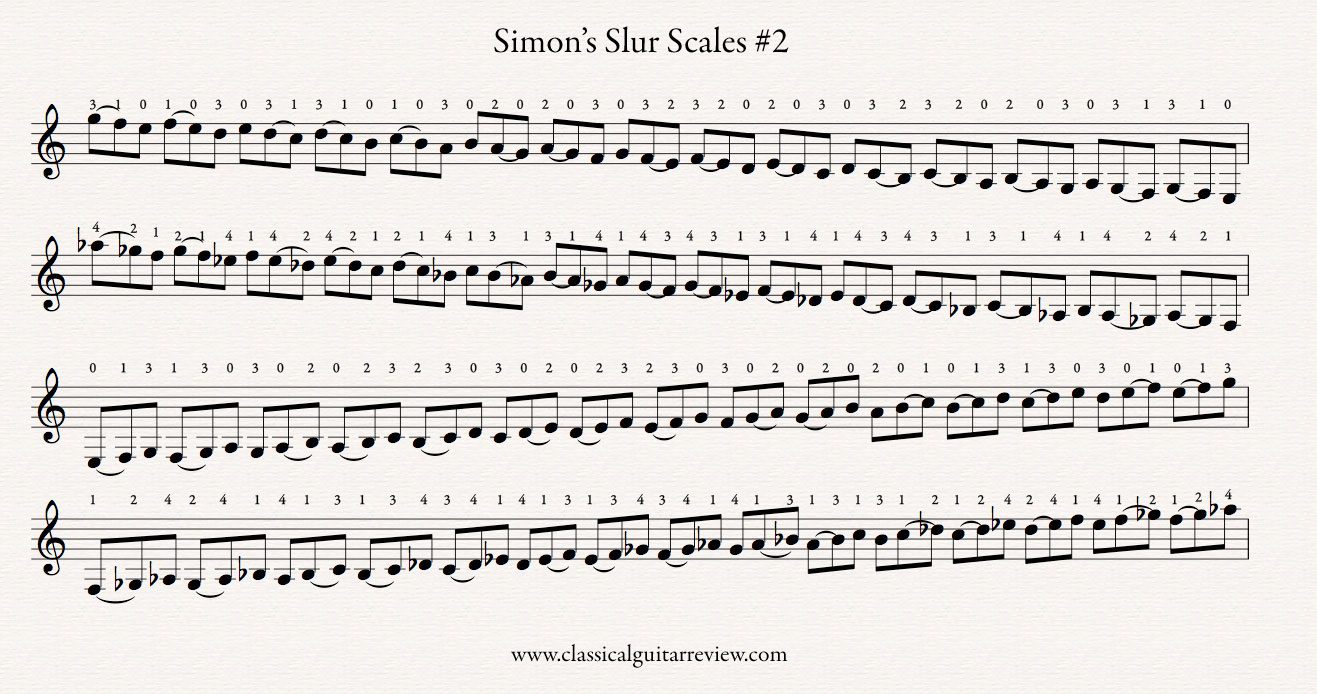How to do a Slur on Classical Guitar
This article goes in depth on how to do a slur on classical guitar. Slurs are an integral part of classical guitar technique. They offer a source of musical expression and they also have many technical advantages that can make difficult passages of music flow with more ease.
Slurs can more or less be divided into two types: musical slurs and technical slurs.
Musical Slurs
Musical slurs can add a legato sound to a phrase, as two notes connected by a slur are not as audibly divided by a right hand stroke. Rather the first note sounds more glued to the next and this connection can come in great use when phrasing music and connecting voices. Generally, the slurred note (the one that is sounded by the left hand) is softer that the struck note that preceded it, which has more of an accent. This tendency lends itself to resolving suspensions, rhythmic grouping and making melodic lines more legato.
Technical Slurs
Technical slurs are ones that make a passage of music more manageable to play. A slur comes in great use when a passage is demanding an awkward right-hand sting crossing or is very fast Adding in a slur can change the right hand alternation pattern making string crosses easier and they can give welcome assistance to executing fast scale passages. Slurs work wonderfully as a ‘springboard’ at the beginning of a scale.

Counter pressure in descending slurs
A very common bad habit that develops in beginners is to pull the string down when making a descending slur. This will distort the pitch of the notes and also make the slur less articulated. This habit can easily go unnoticed by the player and it can be checked by playing in front of a mirror, recording yourself or asking someone to observe your left hand during slur exercises.
The best way to counter this and to make the slur process easier and more effective is to apply some counter pressure from the finger that is not slurring. For example if 2 is slurring to 1 then you can apply some pressure in 1 upwards towards your face. This will prevent you from distorting the string, create a more articulate slur, and make the slur easier to execute.
Practicing Slurs
Slur exercises are great for building up left hand strength and agility they will improve the overall function of the left hand as well as working on the actual technique.
Focus on the movements that are integral to the slur in your exercises and don’t worry too much about playing hundreds of slurs very fast. Be consistent with where your finger comes down in ascending slurs (close to the fret and on the tip of the finger rather than the pad) and focus on making a fast snapping motion in both slur types.
As slurs are naturally softer than a struck note with the right hand try to accent each slur in your exercises making them as loud as possible. This will counter the most common problem of all, which is that the slurred note is too soft and isn’t balanced with the other struck notes.
Dangers associated with slurs
Approach slur exercises with particular caution. It’s easy to strain the small muscles in the left hand and cause injury. As a general rule, at the first sign of pain – stop. Practice your slurs regularly for short periods of time rather than trying to improve your technique through long technical workouts. If you rarely work on slurs then I would recommend a 3 to 5 minute session followed by breaks and other exercises before repeating. For those already undertaking regular slur exercises 5 to 10 minute sessions should be sufficient. Remember that the quality and consistency of the slurs is more important than the speed and quantity.
Ascending slurs
We create ascending slurs (or ‘hammer ons’) by a quick snapping motion with a left hand finger coming down on a string. The motion needs to be quick so as to create enough sound. It is the speed, position and attack of the finger that will make the sound. Use the tip of your finger and be consistent with the placement of the tip close to the fret. Starting the motion of the finger further from the fingerboard will not help produce more sound so be sure to keep a good left hand shape and don’t let your finger ‘flap’ around far away from the fingerboard.
Steps:
1. Place finger 1 on the 5th fret of the 5th string
2. With a concise snapping motion bring your second finger down on the 6th fret on the 5th string
Descending slurs
Descending slurs (known as ‘pull offs’ in contemporary guitar) are essentially rest strokes for the left hand. The term ‘pull off’ has mislead many student over the years because it gives the impression that the finger comes away from the fingerboard. The motion of the finger is lateral towards the adjacent string.
Steps:
1. Place finger 1 and 2 on the 5th and 6th fret on the same string.
2. Sound the first note with a right hand stroke then snap the 2nd finger down to the adjacent string while keeping a good left hand shape.To study this technique in-depth you can take the comprehensive Technique & Musicianship Course Level 2 in our membership. Over 3 hours of video and more than 20 worksheet downloads will guide you through a structured and focused course of study.


How about slurs going to adjacent strings as from b on the 5th string to f sharp on the fourth string,p. Is it ok at times to imitate piano slurs?